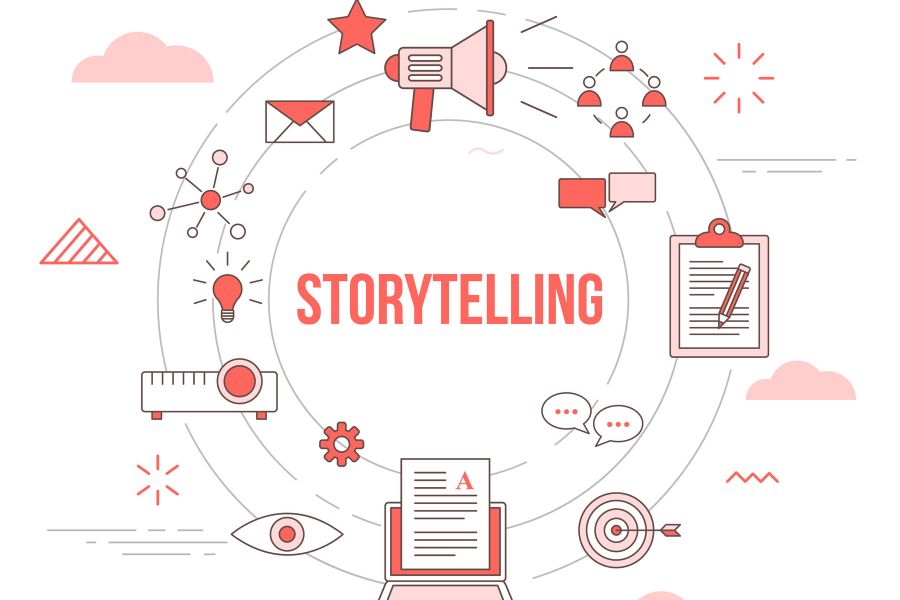Storytelling in Content Writing: Crafting Narratives That Captivate
What is Written Storytelling

Definition and Overview
Storytelling in content writing is a powerful and effective technique that involves the art of narrating a compelling and engaging tale through written words. It goes beyond mere information sharing, aiming to captivate readers and create a lasting impact. In essence, it’s about weaving a narrative that resonates with the audience, making the content memorable and relatable.
Characteristics of Written Storytelling in Content Writing
Emotional connection: Storytelling allows writers to evoke emotions and connect with readers on a personal level, fostering a stronger bond.
Engagement: Well-crafted stories capture the reader’s attention, keeping them engaged and interested in the content.
Memorability: Stories are more likely to be remembered than dry facts, making storytelling an effective method for conveying information.
What are storytelling elements

Character Development
Effective storytelling in content writing often revolves around well-developed characters that readers can relate to. Characters add depth and authenticity to the narrative, creating a more immersive experience for the audience.
- Protagonist and antagonist: Introduce compelling characters that drive the story forward, whether it’s a hero overcoming challenges or an antagonist presenting obstacles.
- Character arcs: Explore the growth and transformation of characters throughout the narrative, providing a dynamic and engaging element to the story.
Plot Structure
A coherent and well-structured plot is crucial for maintaining the reader’s interest and guiding them through the narrative.
- Introduction: Set the stage by introducing the main characters, setting, and the initial conflict or challenge.
- Rising action: Build tension and suspense as the story progresses, introducing complications and obstacles.
- Climax: Reach the peak of the story, where the main conflict comes to a head, creating a turning point for the characters.
- Falling action: Resolve the conflict and address any remaining issues, preparing the story for a conclusion.
Setting and Atmosphere
The setting and atmosphere play a significant role in establishing the tone and mood of the story.
- Descriptive language: Paint a vivid picture of the surroundings, engaging the reader’s senses and immersing them in the narrative.
- Atmosphere: Create an atmosphere that complements the story’s emotional tone, whether it’s suspenseful, lighthearted, or dramatic.
Conflict and Resolution
Conflict is the driving force behind any engaging story, and resolution provides a satisfying conclusion for the reader.
- Types of conflict: Explore different types of conflict, such as internal struggles, interpersonal conflicts, or external challenges.
- Resolution: Conclude the story by resolving the conflict in a way that feels satisfying and meaningful for the reader.
What are storytelling techniques

Use of Descriptive Language
One of the fundamental storytelling in content writing techniques is the use of descriptive language. By painting vivid images with words, content creators can transport readers into a different world, allowing them to visualize and experience the narrative. Descriptive language appeals to the senses, creating a more immersive and memorable reading experience. For instance, a travel blog describing a bustling marketplace might use vibrant adjectives to evoke the sights, sounds, and smells, enhancing the overall storytelling effect.
Incorporating Dialogue
Dialogue is a powerful tool that brings characters and narratives to life. By incorporating conversations between characters, content creators can infuse authenticity and relatability into their writing. Dialogue allows readers to connect with the characters on a personal level, making the content more engaging and enjoyable. Whether it’s a business article or a fictional story, well-crafted dialogue fosters a sense of connection between the audience and the content.
Building Suspense
Building suspense is an effective technique to keep readers hooked throughout the content. Whether it’s a mystery, a product unveiling, or a personal anecdote, strategically withholding information and gradually revealing it creates anticipation. This technique encourages readers to stay engaged until the very end, enhancing the overall impact of the content. The use of suspense is particularly valuable in marketing content, where keeping the audience interested can lead to higher conversion rates.
Employing Foreshadowing
Foreshadowing involves hinting at future events, creating a sense of anticipation and curiosity. This technique not only keeps readers intrigued but also provides a roadmap for the content. By subtly alluding to upcoming developments, content creators can guide the reader’s expectations and build a cohesive narrative. Foreshadowing is especially effective in long-form content, such as blog series or marketing campaigns, where maintaining a consistent storyline is crucial.
Why Storytelling is So Important

Emotional Connection with Audience
Storytelling in content writing fosters a deep emotional connection between the content creator and the audience. When readers engage with a well-crafted story, they are more likely to empathize with the characters or the message being conveyed. This emotional resonance not only enhances the overall reading experience but also creates a lasting impression on the audience.
Memorable Communication
Humans are wired to remember stories more effectively than dry facts or statistics. By packaging information within a narrative, content creators can make their message more memorable. Whether it’s a brand message, a product description, or an educational piece, framing the content as a story increases its impact and ensures that the audience retains key information.
Engaging and Retaining Attention
In an era of information overload, capturing and retaining the audience’s attention is a significant challenge. Storytelling proves to be a solution by providing a narrative structure that keeps readers engaged from start to finish. By seamlessly blending storytelling with content writing techniques, content creators can create content that stands out in a sea of information, holding the audience’s attention and increasing the likelihood of a positive response.
Establishing Brand Identity
For businesses, storytelling in content writing plays a pivotal role in establishing and reinforcing brand identity. By crafting narratives that align with the brand’s values, mission, and personality, companies can connect with their audience on a more personal level. This connection goes beyond mere transactions, fostering brand loyalty and advocacy. Consumers are more likely to remember and support brands that share compelling stories that resonate with their own values.
Why is Storytelling Important in Education

Enhancing Learning Experience
Storytelling injects life into educational content, transforming dry facts into engaging narratives. The use of relatable characters, scenarios, and conflicts helps students connect with the material on a deeper level. By immersing learners in a captivating story, educators can create a more dynamic and memorable learning experience.
Facilitating Information Retention
The human brain is wired to remember stories more effectively than isolated facts. The narrative structure of stories helps organize information into a coherent framework, making it easier for students to retain and recall. This inherent connection between storytelling and memory aids in long-term information retention, a crucial aspect of effective education.
Fostering Critical Thinking
Through the exploration of characters’ motivations, plot developments, and conflicts, storytelling in content writing prompts students to think critically about the subject matter. Analyzing the intricacies of a story encourages a deeper understanding of complex concepts, fostering the development of critical thinking skills essential for academic success and real-world problem-solving.
Encouraging Creativity
Storytelling in content writing nurtures creativity by encouraging students to think beyond the confines of established facts. When learners are prompted to create their narratives or interpret existing ones, they engage in imaginative thinking. This creativity not only enhances their understanding of the material but also prepares them for a future where innovative thinking is highly valued.
Why Use Storytelling in Business

Utilizing storytelling in content writing is an imperative strategy, especially when considering its profound impact on various aspects of business.
Building Brand Identity and Connection: In the dynamic realm of business, storytelling in content writing emerges as a potent tool for shaping brand identity. By weaving narratives that align with their core values, companies can transcend the corporate veil, humanizing their brand and establishing a genuine connection with customers on a personal level. These narratives become the threads that stitch together a compelling brand story, making it more relatable and resonant.
Engaging Customers and Stakeholders: The art of storytelling in content writing possesses the unique ability to captivate audiences, making it an invaluable asset in business communication. Whether conveyed through advertising initiatives, social media platforms, or woven into the fabric of company narratives, stories have the power to seize and sustain the attention of target audiences. This engagement goes beyond the transactional, fostering a deeper connection that goes beyond mere consumerism.
Enhancing Marketing and Communication Strategies: Storytelling, when skillfully incorporated into content writing, transcends the realm of mere information. It transforms marketing messages into memorable experiences, adding an emotional layer that resonates with the audience. This not only makes the content more appealing but also contributes to the effectiveness of marketing and communication strategies. By marrying information with emotion, businesses can create a lasting impact on their audience, ensuring that their message is not just heard but also felt.
How Storytelling Works

Cognitive Impact on the Brain
Scientifically, storytelling in content writing has a profound impact on the brain. When we hear a well-crafted story, various regions of our brain are activated, including those responsible for processing emotions, language comprehension, and sensory experiences. This multisensory engagement enhances the overall learning experience, making content more memorable and enjoyable.
Psychological Aspects of Story Reception
Stories evoke emotions, creating a connection between the content and the reader or audience. This emotional engagement makes the information more meaningful, increasing the likelihood of retention. Moreover, the psychological immersion in a narrative allows individuals to empathize with characters, creating a more profound and personal connection to the subject matter.
Impact on Reader or Audience
In content writing, understanding the impact of storytelling on the reader or audience is crucial. Effective storytelling in content writing generates interest, captures attention, and motivates individuals to continue reading or listening. This captivation ensures that the intended message is not only received but also internalized, maximizing the effectiveness of the communication.
Real-life Applications in Content Writing
Storytelling is not confined to the realm of education; its applications extend to various forms of content writing. Whether crafting marketing materials, blog posts, or social media content, incorporating storytelling techniques can significantly enhance engagement. By weaving narratives into the fabric of your content, you can create a more compelling and memorable message that resonates with your target audience.
Parting Wisdom

In the expansive realm of content creation, Write Ink recognizes storytelling as a potent instrument for establishing connections with audiences, effectively communicating messages, and etching a memorable imprint. Through adept mastery of storytelling in content writing elements and techniques, our skilled writers craft content that not only imparts information but also deeply resonates. This approach ensures a profound and lasting impact in the hearts and minds of our readers, setting Write Ink apart as a premier content writing agency.
FAQs (Frequently Asked Questions)
Q1: What is the significance of storytelling in content writing?
Storytelling in content writing is significant because it creates an emotional connection with the audience, makes information memorable, and transforms complex concepts into relatable narratives. It serves as a powerful tool to engage readers and leave a lasting impact.
Q2: How does written storytelling differ from other forms of storytelling?
Written storytelling in content writing relies solely on the written word to convey a narrative, allowing for a deep exploration of characters, plot, and settings. Unlike other forms, it engages readers through the power of language, painting vivid images and evoking emotions.
Q3: What elements are crucial in storytelling for content writing?
Essential storytelling in content writing elements include well-developed characters, a thoughtfully constructed plot, a carefully chosen setting, and a compelling conflict. Character development, in particular, plays a crucial role in creating a narrative that resonates with the audience.
Q4: How can storytelling enhance comprehension in education?
Storytelling in content writing enhances comprehension in education by presenting concepts in a relatable context. Students are more likely to understand and remember information when it is woven into a narrative, fostering critical thinking and creativity.
Q5: Why is storytelling important in business?
In business, storytelling is crucial for building brand identity, engaging customers, and enhancing marketing strategies. It humanizes the brand, connects with the audience on a personal level, and transforms marketing messages into memorable experiences.
Image Reference: Freepik
Disclaimer: All trademarks, logos, and brand names are the property of their respective owners. All company, product, and service names used in this website are for identification purposes only. Use of these names, trademarks, and brands does not imply endorsement.







